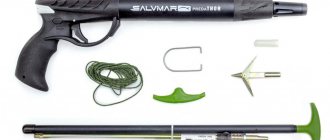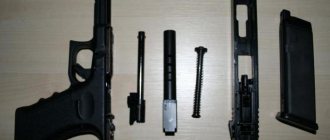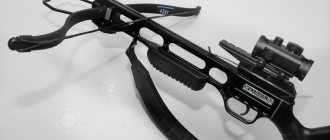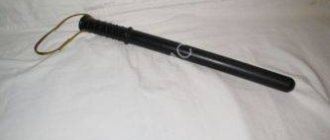Legal topics are very complex, but in this article we will try to answer the question “How to properly put on handcuffs during the exam for security guards.” Of course, if you still have questions, you can consult with lawyers online for free directly on the website.
Positive result: performing at least six blows with a rubber stick on a dummy within the specified time, without allowing blows to areas corresponding to areas of the human body that are not allowed to be impacted.
Appendix No. 2 to the Regulations on the conduct of periodic inspections by the internal affairs bodies of the Russian Federation of private security guards and employees of legal entities with special statutory tasks for suitability for action in conditions associated with the use of firearms and special means
Information about changes:
Typical exercises for the practical use of special means, the implementation of which is intended for private security guards of categories 4, 5, 6 and employees of legal entities with special statutory tasks when undergoing periodic testing for suitability to act in conditions associated with the use of special means
There are a number of models of handcuffs, which are characterized by increased complexity of the lock design. An example is the BRS-2 handcuffs. In such models, the lock is similar to door locks, and working with them is more painstaking.
- To make it more convenient to free yourself from handcuffs, you must first try to make sure that your hands are in front. Of course, doing special gymnastics or yoga will help in this case, but not everyone can have special physical training for such exercises. And yet, to safely free yourself from handcuffs, you first need to place your hands in front.
- Now you need to find an available tool for picking the lock. This can be any fairly hard object pointed at one end: a paper clip, needles, a small sharp nail, or even a match. However, according to numerous surveys of those who have already had experience in opening the lock of handcuffs using improvised means, rigid thin wire is recognized as the most effective, since non-metallic objects can break when opening the lock if the skill is insufficient.
- Next, it is recommended to bend the wire at a right angle. This will allow you to penetrate into the lock mechanism without causing serious damage to it and at the same time ensuring the tightest possible grip. The bend of the wire should be done at a distance of approximately 4-5 mm from its end. A flat metal plate can be considered an ideal option for such purposes: when exposed to the lock, it undergoes minimal deformation and is the most durable.
- Now, depending on the model of handcuffs, you can proceed to the main goal: opening the lock. Since they differ in the mechanism and fixation device, the opening method differs.
From a trouser belt
Opening such a lock will require the use of two pieces of high-strength wire. Both pieces should be bent at a right angle at a distance of 3-4 mm from the end. Having inserted them from different sides of the lock, you need to be able to feel inside the plate that holds the lock, and use one part of the wire to move the latch to the left side, and to the right - both parts of the lock plate.
We recommend reading: Compensation for Pensioners of the Ministry of Internal Affairs 2020
The person being tested is 1.5 meters opposite the dummy. The handcuffs are on the belt in a case. At the inspector’s command: “Put handcuffs in front (or behind)!” the person being checked takes the handcuffs out of the case, approaches the dummy, puts on the handcuffs and fixes their bracelets. After that he reports: “The handcuffs are on.” Exercise time: 25 seconds. When put on, the handcuffs should rotate freely and securely fix the limb. After checking the correctness of putting on the handcuffs, at the inspector’s command: “Remove the handcuffs!”, the person being inspected removes the handcuffs. Positive result: handcuffs were correctly applied within the specified time and then removed.
STANDARD EXERCISES FOR THE PRACTICAL APPLICATION OF SPECIAL TOOLS, THE IMPLEMENTATION OF WHICH IS PROVIDED FOR PRIVATE GUARDS 4, 5, 6 CLASSES AND EMPLOYEES OF LEGAL ENTITIES WITH SPECIAL STATUTORY TASKS WHEN PASSING PERIODIC APPLICABILITY TESTS TO ACTIONS IN CONDITIONS RELATED TO THE USE OF SPECIAL MEANS
How to pass testing for special equipment of a security guard of 4, 5, 6 categories
Appendix No. 2 to the Regulations on the conduct of periodic inspections by the internal affairs bodies of the Russian Federation of private security guards and employees of legal entities with special statutory tasks for suitability for action in conditions associated with the use of firearms and special means
The person being tested is 1.5 meters opposite the dummy. The rubber stick is on the belt (in the PR suspension). At the command of the supervisor “Start the exercise,” the person being tested removes the rubber stick from the suspension and strikes the dummy (at least six) in various zones allowed for impact with the rubber stick. After this, the person being tested reports: “I have finished the exercise.”
How to open and remove handcuffs without a key
A lock built into the welded chain of links is responsible for opening the handcuffs. It may differ for similar models, but the main principle of its operation should be considered an increased level of secrecy: the possibility of its unauthorized opening largely depends on this. A key is usually included in the kit, but two keys may also be included. However, if you have only one key, you should make a duplicate of it: this will help avoid an unpleasant situation if the key is lost and difficulties arise in removing the handcuffs.
Most often, the design of handcuffs is such that the lock is located beyond the reach of the attacker’s hands while handcuffed. This is done from the point of view of protecting against the possibility of unauthorized opening of the handcuffs. If the lock is located in such a way that it can be accessed from both sides (through lock), then such a lock will have an increased degree of possibility of breaking.
The handcuffs are opened using a key. However, there are several ways to free yourself from handcuffs without using the included key. Let's consider the main stages of “liberation” from them.
- To make it more convenient to free yourself from handcuffs, you must first try to make sure that your hands are in front. Of course, doing special gymnastics or yoga will help in this case, but not everyone can have special physical training for such exercises. And yet, to safely free yourself from handcuffs, you first need to place your hands in front.
- Now you need to find an available tool for picking the lock. This can be any fairly hard object pointed at one end: a paper clip, needles, a small sharp nail, or even a match. However, according to numerous surveys of those who have already had experience in opening the lock of handcuffs using improvised means, rigid thin wire is recognized as the most effective, since non-metallic objects can break when opening the lock if the skill is insufficient.
- Next, it is recommended to bend the wire at a right angle. This will allow you to penetrate into the lock mechanism without causing serious damage to it and at the same time ensuring the tightest possible grip. The bend of the wire should be done at a distance of approximately 4-5 mm from its end. A flat metal plate can be considered an ideal option for such purposes: when exposed to the lock, it undergoes minimal deformation and is the most durable.
- Now, depending on the model of handcuffs, you can proceed to the main goal: opening the lock. Since they differ in the mechanism and fixation device, the opening method differs.
Lock without active latch
The presence of a locking device is determined by visual inspection of the handcuffs. Typically, there is a lever on the flat surface of the underside of the lock mechanism that is recessed into a hole. If the latch is not observed in the hole, it means that it is not active. In a number of models in this case it is completely absent.
And in order to be able to open handcuffs of this model using improvised means, you should imagine the mechanism for burying the handcuffs when they are fixed on the hand. The teeth located on the lower moving part, when they come into contact with the grip, set the lock pawl in motion, it falls and closes the handcuffs. When the key is used, the teeth are caught and raised, allowing the lock to be opened.
This video will show you how to open and remove handcuffs without a key using a paper clip:
Availability of active latch
To open such models, you must first disable the latch, otherwise the lock will slip and will not open. To do this, when the wire penetrates the lock, feel it and turn it counterclockwise. You must act as carefully as possible, otherwise there is a high probability that the latch will operate.
Handcuffing procedure
Before removing the handcuffs, the handcuff key must be turned to the “open” position. In BRovsky handcuffs, you should turn it twice in the opposite direction from the clockwise movement. Then, when holding it in this position, the locking mechanism is uncoupled from the toothed half-clips. In BR-Osv handcuffs, the key is first turned counterclockwise (to release it from locking), and then in the opposite direction. When the key is held in this way, the locking mechanism is uncoupled from the toothed half-clips.
How to remove handcuffs
At the same time, for the first time, the product was equipped with a ratcheting mechanism, which meant that the upper arms of the handcuffs could easily rotate in only one direction. In the opposite direction, the ratchet was held with a key. The handcuff bracelets were connected to each other using welded steel chain links. The product created then has reached us practically unchanged.
After completing the training and receiving the appropriate certificate, to obtain a license according to the specified category, you must contact the Licensing and Permitting Department (LRO) at the appropriate police department.
- who are not citizens of the Russian Federation;
- under 21 years of age;
- those who have been convicted of committing an intentional crime or who have been charged with committing a criminal offense (until a court decision);
- recognized by the court as incompetent or partially capable;
- have not passed the medical examination;
- who have not undergone special professional training;
- suspended by the court from working in the Ministry of Internal Affairs or any branch of government;
- former civil servants dismissed on compromising grounds;
- whose license was canceled due to violation of the legislation on security activities and less than a year has passed since the cancellation;
- who were denied permission to work based on the results of an inspection conducted by the Department of Internal Affairs or the FSB;
- have not passed the mandatory fingerprint examination;
- registered with health authorities for mental illness, alcoholism or drug addiction.
How to make a device with your own hands
There are several options for making handcuffs from materials on hand. To understand the manufacturing principle, you should consider the most popular ones. These are improvised handcuffs made from an ordinary trouser belt and clothesline: these are the materials that should be considered the most durable and affordable.
From a trouser belt
The most popular option for making handcuffs yourself is the option from a regular trouser belt. For this purpose, a belt is used that is sufficiently wide and provides the necessary fixation on the hands. It is recommended to use a belt that is not smooth or varnished to prevent your hands from slipping into the loops.
The main idea of the technique is to fix the hands as rigidly as possible. According to reviews from those who have tried this technique, creating two loops that cross each other, this type of homemade handcuffs is not considered reliable: with narrow hands, with some effort, simply widen the loops to the required width and free your hands.
A more effective method is to position the belt in such a way that the hands are placed inside two belt loops, which are located one inside the other. In this case, after placing the hands inside these loops, the belt is fastened with a buckle, which gives the greatest rigidity to the resulting connection.
From a clothesline
To make handcuffs you will need about 60 cm of rope, which you can buy at a hardware store. They have a high degree of strength, are durable and affordable.
The scheme for making homemade handcuffs is as follows:
- make two adjacent loops in the central part of the handcuffs;
- Now you should thread the second one into one of the loops - this will create a knot in the middle of the rope and two loops at the edges, which will become handcuffs in the final version;
- The attacker's hands are inserted into both loops, which are then tightened, and the ends of the rope secure the handcuffs around the hands and forearms.
Now the ends of the rope are tied into a strong knot. It is quite difficult to untie it when your hands are fixed in one position and there is no possibility to use cutting objects.
The video below will help you make handcuffs:
How to properly wear handcuffs during a security guard exam
Recipients of pension payments enjoy, on a general basis, the right to a refund of income tax when purchasing real estate. With the consent of the employee, the recall may be interrupted at another time, but the employee retains the right to use the remaining days immediately after the urgent need for his presence at work ceases. If there are several owners registered in the apartment, is their written consent necessary for temporary registration, provided that I am going to register my daughter on my part of the property.
Practical part
Practical skills testing is distributed by category.
For all ranks of security guards, there is a test of skills in handling a protective helmet, body armor, rubber truncheon and handcuffs. Upon successful completion of the theoretical exam, the security guard is asked to draw a ticket on which one of the special means listed above will be written. Next, for the fifth rank of security guard, there is a test of skills in handling civilian weapons, and for the sixth rank, with service weapons.
Each region and exam center interprets certain practice rules differently, but we will still try to highlight the most common mistakes made by security guards.
Protective helmet.
If you get a protective helmet, then before you begin the exercise, you should make sure that you are not putting it on backwards. Of course, this is not a fireman's helmet , where the front part is easily determined by the protective glass. So take your time, carefully examine the helmet before the exercise, try to unfasten and fasten the helmet clasp.
Body armor.
A common mistake when putting on body armor is that the fasteners of the body armor are at the back. At the same time, the examinee begins to rotate it on himself, losing precious time (no more than 20 seconds are allotted for each exercise).
Rubber stick.
You will be asked to hit the dummy 4 or more times (depending on the examiner's mood). You cannot hit the head, neck, clavicular area (often the examiner asks to show this place), stomach, or genitals.
You do not need a handcuff key to handcuff the mannequin. Most often, handcuffs are triggered instantly when struck on the wrists. Also, do not put pressure on your wrist with the handcuffs; the rings of the handcuffs should turn freely.
We have made a brief overview of the practical part of the exam testing skills in handling special equipment. By studying in Penza, you will be able to master all the skills well and successfully pass the qualifying exam.
How to properly put on handcuffs during the security guard exam
Vladimir Avilov. A program for hand-to-hand combat is presented, taking into account the specific tasks of military intelligence special forces units. The technique of destroying the enemy in hand-to-hand combat, as well as capturing him, is shown. Patrol techniques and actions. Demonstrated: striking technique; close combat: throws, painful holds, releases from holds and grabs; counteraction against blows with edged weapons, attacking actions with edged weapons, bayonet fighting techniques, disarming; capture: external inspection, tying up; tactical and technical actions, hand-to-hand combat techniques using improvised objects. Vladimir Avila. Presented a program on hand to hand combat with specific tasks special forces units of military intelligence. Shows the technique of destroying the enemy in close combat. as well as capture. Techniques and actions patrols. Showcased. striking techniques. melee. throws, locks. release from seizures and girts; resistance against impact machetes. the attacking with machetes. receptions bayonet fighting. disarm. capture of. external examination. the binding. the tactical and technical actions. unarmed combat, using the materials at hand .
» How to dress correctly
The person being tested is located near a table with protective helmets of class 1 and 3. At the command of the supervisor, “Put on a protective helmet of 1 (or 3) class,” the person being tested puts on a protective helmet of the specified class and reports: “I have finished the exercise.”
Notes: When performing exercise 1, a protective helmet is worn only if sanitary and hygienic standards are observed, using the personal headgear of the worker being tested, a napkin, liner, etc. Exercises 3 and 4 are performed on a dummy. Requirements for a mannequin: the mannequin must follow the contours of the human body; head and limbs are required; The upper limbs should imitate the structure of the hand and have 3 degrees of freedom to ensure the exercise is performed.
We recommend reading: Deductions for the Pi Fund upon Dismissal of an Employee in 2020
How to pass testing for special equipment of a security guard of 4, 5, 6 categories
Testing a security guard for knowledge and use of special equipment is one component of the periodic inspection of a security guard. Although many will say at first glance that it is not so difficult, but judging by surveys, 85% of security guards who could not pass the test the first time “fail” on this test. Why is this happening? The reason is very simple. When you answer the theoretical tickets of the qualifying exam here, everything is simple, you just need to know the correct answer. In testing for knowledge and use of special equipment, tickets are also used, but you have to answer practically and here the “marketing frequency” of the inspectors is turned on, who often each have their own interpretation of the correct execution of a practical question, which often differs from the interpretation of execution set out in the orders of the Ministry of Internal Affairs. Another reason is the guard’s lack of knowledge of special equipment, who cannot, for example, distinguish a PR-K from a PR-73M. Let's consider these questions in more detail:
The person being tested is 1.5 meters opposite the dummy. The handcuffs are on the belt in a case. At the inspector’s command: “Put handcuffs in front (or behind)!” the person being checked takes the handcuffs out of the case, approaches the dummy, puts on the handcuffs and fixes their bracelets. After that he reports: “The handcuffs are on.” Exercise time: 25 seconds. When put on, the handcuffs should rotate freely and securely fix the limb. After checking the correctness of putting on the handcuffs, at the inspector’s command: “Remove the handcuffs!”, the person being inspected removes the handcuffs. Positive result: handcuffs were correctly applied within the specified time and then removed.
Weapon
The employee being inspected is located near the table with protective vests of class 1 and 5. At the command of the supervisor, the inspected employee puts on a protective vest of the specified class and reports: “The protective vest of class 1 (or class 5) is on.” The exercise time is 20 seconds.
This is interesting: Characteristics of a mother for a letter
The worker being checked is located opposite the dummy (1.5 meters). The rubber stick is on the belt in a case; at the command of the manager, the rubber stick is removed from the case and blows (at least six) are applied to the dummy in various permitted zones. The exercise time is 20 seconds.
The device of shackles
The shackles consist of massive metal bracelets and a chain. The chain was made large so that a prisoner could not hang himself with it or easily strangle another prisoner or guards. The shackles were closed with a metal rod, which was difficult to remove in the field. In the Middle Ages and modern times, various types of castles began to be used. The bracelet had different sizes and could be adapted to be worn on the arms, legs, and also on the neck. The chain could connect both wrist and leg shackles separately, or combine them into a single system that seriously limited freedom of movement. Shackles could be nailed to walls or floors, and a load or heavy object could be suspended from them. For example, in the penal system of the Russian Empire, a prisoner was chained to a wheelbarrow that weighed almost 80 kilograms. Keeping prisoners in shackles ceased to be practical with the advent of modern prisons. Nowadays, shackles are used only as a fetish object.
How the exam goes and what the results are
The purpose of the exam is to determine the level of readiness of a security guard to perform his official duties, to follow the legislation of the Russian Federation in the course of his professional activities, since the specifics of working as a security guard and, in particular, the possession and use of weapons require careful selection of personnel for security companies.
Where to see questions
More than 10 years have passed since the introduction of compulsory licensing of security activities, and during these years qualification exams are regularly held; the number of questions in them is constantly changing, although the essence of the questions remains unchanged.
Private security guards who have undergone appropriate training and passed an annual test for professional suitability to act in situations involving their use have the right to use special means.




